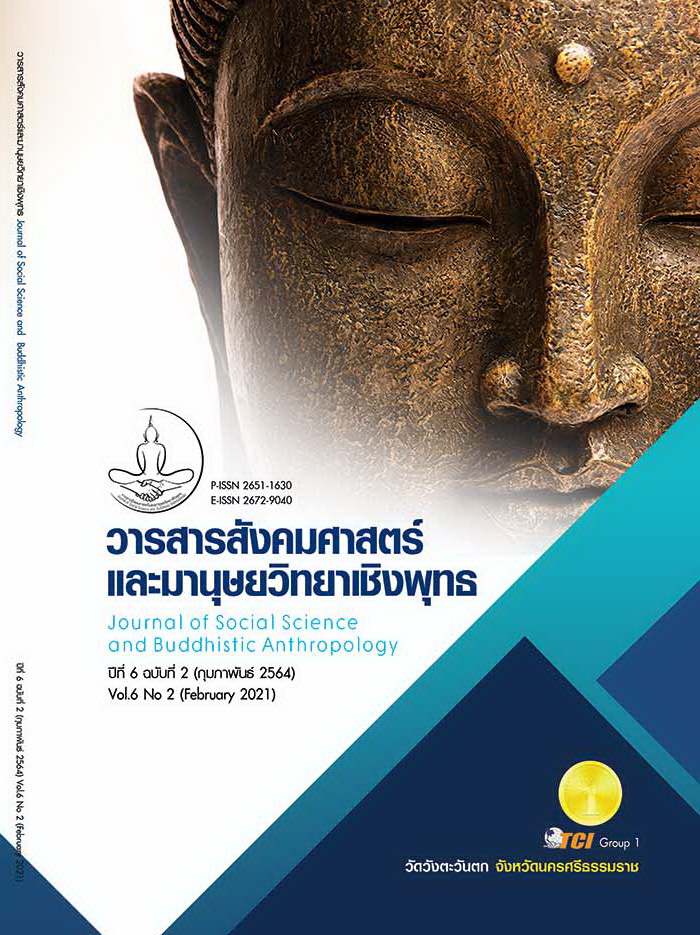MODELS AND CHARACTERS OF RECONCILIATION ACCORDING TO BUDDHIST DISCIPLINE APPROACH AND THAI MONK BUDDHIST SCHOLAR ATTITUDES
Keywords:
Reconciliation, Thai Monks, Buddhist DisciplineAbstract
The Objectives of this research article were to 1) to study the concept of reconciliation and model of conflict diminution based on Buddhism perspectives; and 2) to analyze the model and characteristics of diminishing the conflicts in peaceful means of monks. Documents were reviewed, and field studies were also conducted. The population consisted of 5 monks and 5 academicians. The research instrument was a structure interview and un-structure interview. The results of research were found as follows: 1) concept of reconciliation and model of conflict diminution based on Buddhism perspectives found that the arrangement interpersonal relationships and groups. The cause of the conflict is not complicated because the society in the Buddha era is a simple society found that the group have problem was 1) the monks with problems about understanding is different. Problems of monks with understand of discipline to the conflict of the monk group. 2) The problem of person and person, person with government about human rights violation or conflict in the law. 3) The problem of people or government with government and the pattern of reconciliation in the Buddhist era can lead to problem solving as follows: 1) Buddha or mediator 2) the conditions of the conflict and problem solving, 3) the conflict 4) the problem solving process, and 5) the goal of conciliation 2) Analyze the patterns and characteristics of conflict management by peaceful according to the opinion of Buddhist academician share the idea. The conflict comes from the fundamental factors of human psychological have unwholesome roots (greed, hatred and delusion). The problem solving of conflict by dharmic principle as follows four sublime states of mind and aparihaniyadhamma.
References
กัญญาณัฐ พานทอง. (2558). การเมืองและความขัดแย้งในองค์กรปกครองส่วนท้องถิ่น: กรณีศึกษาเทศบาล แห่งหนึ่งในภาคตะวันออก. ใน ภาคนิพนธ์รัฐประศาสนศาสตรมหาบัณฑิต. สาขาวิชาการปกครองท้องถิ่น. มหาวิทยาลัยราชภัฏรำไพพรรณี จันทบุรี.
ชลากร เทียนส่องใจ. (2553). การเจรจาไกล่เกลี่ยคนกลางเชิงพุทธ: หลักการและเครื่องมือสำหรับการจัดการความขัดแย้ง. ใน วิทยานิพนธ์พุทธศาสตรมหาบัณฑิต. สาขาวิชาพระพุทธศาสนา. มหาวิทยาลัยมหาจุฬาลงกรณราชวิทยาลัย.
พรสุข หุ่นนิรันดร์ และคณะ. (2552). หนังสือเรียน รายวิชาพื้นฐาน สุขศึกษา ชั้นมัธยมศึกษาปีที่ 4. กรุงเทพมหานคร: อักษรเจริญทัศน์.
พระครูวิชิตกิจจาภิวัฒน์ (จนฺทโชโต). (2560). พรหมวิหาร : ธรรมแนวทางการแก้ไขความขัดแย้งของสังคมไทย. ใน วิทยานิพนธ์พุทธศาสตรดุษฎีบัณฑิต. สาขาการจัดการเชิงพุทธ. มหาวิทยาลัยมหาจุฬาลงกรณราชวิทยาลัย.
พระพรหมบัณฑิต (ประยูร ธมฺมจิตฺโต). (2555). สุขภาพใจ. กรุงเทพมหานคร: สุขภาพใจ.
พระมหาไพรัชน์ ธมฺมทีโป, ดร. (2561). พุทธวิธีในการปรองดอง. วารสารมหาจุฬาวิชาการ, 5 (ฉบับพิเศษ), 176-196.
พระมหาศิวะเสน ญาณเมธ. (2561). รูปแบบการบริหารจัดการความขัดแย้งในพระพุทธศาสนา: วิเคราะห์จาก พระไตรปิฎก. ใน วิทยานิพนธ์ปรัชญาดุษฎีบัณฑิต สาขาวิชาการบริหารการศึกษา. มหาวิทยาลัยสยาม.
พระมหาสนอง ปัจโจปการี. (2553). มนุษย์กับสังคม. กรุงเทพมหานคร: บริษัท แอคทีฟ พริ้นท์ จำกัด.
มหาวิทยาลัยสุโขทัยธรรมาธิราช. (2555). มนุษย์กับสังคม. กรุงเทพมหานคร: ห้างหุ้นส่วนจำกัดอรุณการพิมพ์.
ลิขิต ธีรเวคิน. (2553). ความขัดแย้งและการแก้ปัญหา. วารสารสถาบันพระปกเกล้า, 8(1), 8-22.
Murphy, Colleen. (2010). A Moral Theory of Political Reconciliation. Cambridge: Cambridge University Press.
Prettynoonum. (2558). สังคมไทยในปัจจุบัน. เรียกใช้เมื่อ. กันยายน 28, 2563, จากhttps://lalidayanapat.wordpress.com/2015/03/23/lalida/








